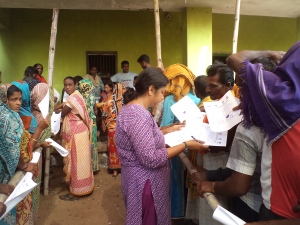This is a short summary of insights and inferences I have drawn upon from my experience in Oxfam India Cyclone Odisha response programme implemented in Puri, Ganjam and Balasore districts in 2013.
With the help of practical observations and direct implementation of the programme, I came across these challenges and reflections.
The critical nature of emergency response warrants for immediate short-term measures to save lives: some of the issues that crop up hence are related to targeting the most vulnerable vs. reaching out to entire communities. The impacts of such short-term decisions lie at the interface between the relief/emergency and longer-term recovery objectives of the communities. The experience was useful for me to learn how proposals were developed, how and what lessons from previous evaluations and experiences were incorporated, how consortium of different INGOs work together, how organizations retain (or do not) the experiences and learning of the consultants.
On resilience (in terms of preparedness) and how ensuring strict state protocol for early warning and evacuation system saved lives and important valuables. There were so many gaps and delays in govt response to the affected communities with relief items. Onslaught of secondary/multiple disaster such as cyclones and floods affecting different districts at the same time was very similar to what I observed in Assam as well – conflicts, repeated floods and erosion. The State machinery lags behind in responding to multiple challenges.
Few other lessons were: –
- Preparedness should not be the only yardstick to measure resilience. It saves lives definitely when disaster strikes, but resilience should also be determined by how communities actually recover and what are the gaps and how long it takes to recover completely. The unmet needs of communities – the most marginalized ones were livelihoods and shelter, which does not warrant adequate response from the govt whose primary mandate is relief-based. This is concurrent to what I observed even in Assam.
- Within each village, hamlet, district there are major groups of people who are left out – invisible groups, the most vulnerable (poor, socio – economically the lower strata) – from the relief or rehabilitation intervention by government and even by NGOs; households who do not own the land, or fisherman who cannot afford to own boats, are left out from receiving benefits due to lack of papers to prove.
- This brings to mind the difference between what agencies such as Oxfam or others can do in events such as cyclones – do they respond to chronic issues of under-development or mal-development in most cases or to acute problems that arose due to the disasters.

